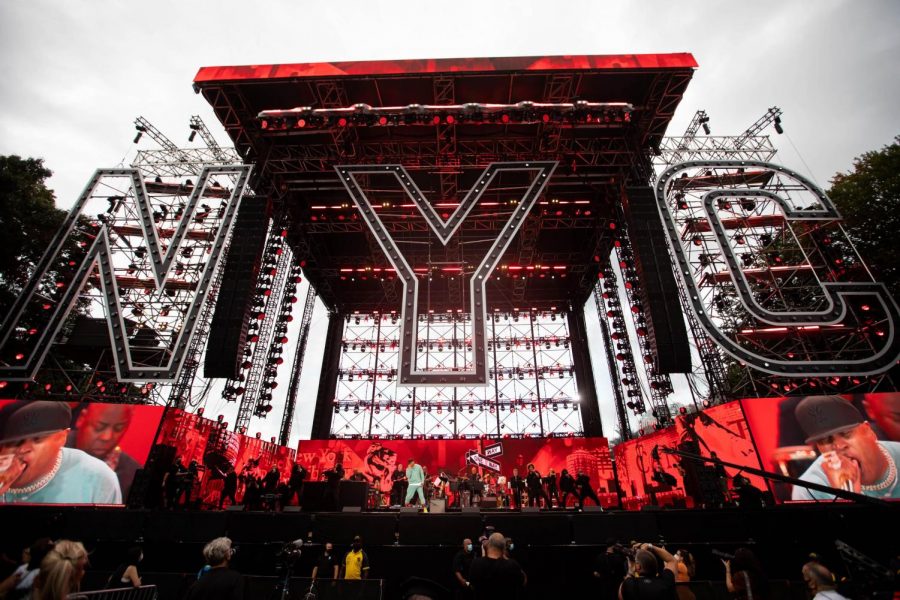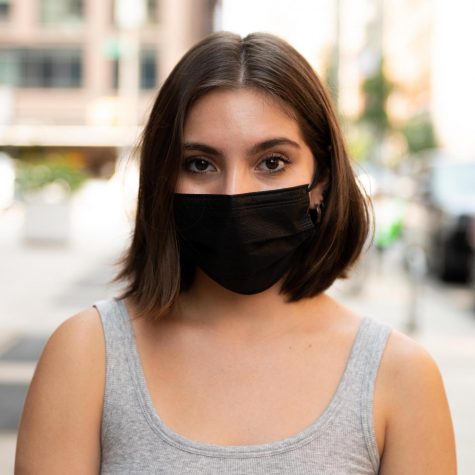Review: ‘WE LOVE NYC: The Homecoming Concert’
New York’s anticipated COVID-19 recovery event was an off-key, optimistic celebration, until halted due to Hurricane Henri.
A star-studded lineup of musicians celebrating the return to semi-normalcy drew large and enthusiastic crowds. Unfortunately for the revelers, the event was cut short due to lightning from Hurricane Henri. (Image courtesy of Michael Appleton/Mayoral Photography Office)
August 30, 2021
With a Broadway-like dazzle, “WE LOVE NYC: The Homecoming Concert,” was a candy-coated outlook on the city’s resurgence after COVID-19. In the assortment of indulgent performances, hesitation was absent, and only the positives were noticed by the audience. The optimism floated above current events until Hurricane Henri brought things back to reality.
The concert took place on Aug. 21 in Central Park’s Great Lawn to celebrate the city’s vaccination efforts and return to semi-normalcy. The event marked the end of eight days of celebratory events across the five boroughs. For the grand finale, music industry icon Clive Davis, the namesake of NYU’s Clive Davis Institute of Recorded Music, worked with New York City and Live Nation to develop a flashy lineup. The artists span genres and eras, from Andrea Bocelli to Maluma, with The Killers, Elvis Costello, Paul Simon and audience favorite Bruce Springsteen as headliners.
It was a pride-filled party for New York, with the same kind of idealistic patriotism as the Fourth of July — aesthetic idolization of the city’s landmarks and characterics became the background for performances. New York-themed songs were scattered in between performances, or even overtly integrated. The New York theme also found its way into the clothing sported at the event — Rob Thomas wore a New York or Nothing tee and a flood of John Lennon’s famous black and white New York City shirts were found throughout event staff and concertgoers.
Concertgoers acted as if they each drank three coffees before the event, showcasing an excitement that carried into the breaks between acts. These brief pauses were filled with the kind of classic tracks that are usually found among family barbecues and middle school dances. As much as they seemed to discriminate little in their excitement towards artists, the audience howling of “Bruce” was as eminent as hearing “Free Bird!” shouted at a rock concert.
The Homecoming event opened with the New York Philharmonic, an orchestra whose music has been stereotyped as stuffy and uppity. Any preconceived notions of the group were defied. The orchestra began with the overture to Bernstein’s “Candide” before melting into Gershwin’s “Rhapsody in Blue,” Christopher Cross’ “Arthur’s Theme (Best That You Can Do)” and a rendition of “New York, New York.” Their swift blending of tracks sparked fist pumping and shouts of thrill and surprise; clarinet solos and climaxes in the medley kindled hearty whoops.
When the Philharmonic’s time seemed to be coming to an end, Italian tenor Andrea Bocelli joined them on stage. As he sang the Neapolitan song “’O Sole Mio” backed by a fleet of strings, Bocelli’s voice was dense with emotion and furiously unwavering. Were the crowd not already standing, I’m certain they would have risen to their feet.
After Bocelli exited the blinged-out stage, Jennifer Hudson gracefully appeared. Her performance was brief, but potent. She sang Puccini’s “Nessun dorma,” a well-adored opera classic.
The man standing in front of me turned around, pointed at his arm and said, “Look, goosebumps!” There is no better summary of Hudson’s performance at the concert.
In a stark turn of genres, the softhearted rock band Journey prompted ferocious singing from the crowd. Arnel Pineda, a new and improved version of Steve Perry, led the audience in “Any Way You Want It” and “Don’t Stop Believin’,” with an abstract design of New York’s subway map serving as their background.
Like Journey, singer Carlos Santana shared his hits “Maria Maria” with Wyclef Jean and “Smooth” with Rob Thomas. Although a slightly rigid performance, Santana’s charisma and presence were enough to make up for it. Earth, Wind & Fire performed similarly — concise and without improvisation, but lively and gratifying.
Each performance felt like a tease, a display of the classics that only made the ending of the acts that much more tragic. And whether it was underwhelming or as thrilling as expected, there was no time to savor what was experienced before the next artist emerged.
While most performers sang two full songs and others strung together the catchiest of their hits, LL Cool J made the most of his time. He and his ensemble of accompanying artists stormed the stage with a compilation of hip-hop hits from five decades’ worth of the genre’s history. Audience members were gasping for breath from both rapping along with surprise guests Run of Run-DMC, Fat Joe, Grandmaster Flash and the Furious Five’s Melle Mel and Scorpio.
But nobody exuded more energy and enthusiasm than Jon Batiste. His positivity was that of a Disney character, his dancing a mix of James Brown and a puppet on strings. He sang “Freedom,” a track fitting for the extravagant optimism of the event.
The celebration was just starting to peak when Hurricane Henri began to make itself known with subtle clouds and trickles of rain.
Barry Manilow was the unlucky victim of the demise of the concert. The hitmaker sang the tropical-influenced “Copacabana” and “Mandy” before being cut off while singing “Can’t Smile Without You.” His pure, jubilant spirit radiated from the stage, which made the timing of the alert all the more unfortunate.
The blind positivity that hung over the event was undercut by the weather, and the concert halted in a seemingly split-second decision. Screens once showing aesthetically worn down apartment buildings and the Statue of Liberty now asked over 60,000 audience members to evacuate immediately. Murmurs of confusion and annoyance, shouts of “Bruce” and remarks of “poor Barry” were heard in the process.
With the concert’s slyly eerie undertone, Hurricane Henri was almost a manifestation of all that was overlooked to make the celebration happen. If the concert occurred at a safer time, it would have been as iconic as anticipated. It is disappointing that such an explosive event, of its capacity and caliber, was thrust naively into a moment too early.
A version of this article appears in the Monday, August 30, 2021, e-print edition. Email [email protected].


























































































































































James B Berg • Aug 30, 2021 at 7:29 pm
Normally I enjoy all kinds of concerts. I like older and newer artists but I was insulted by the way the ” TV Directors” presented Earth Wind and Fire This well respected and established group of Black American entertainers were shown in a very chopped up way. For example After the group sang for a few seconds! the camera showed the NY Skyline, people in the crowd talking , panned back from the crowd, a sideways shot of the back up singers, then another view of Central Park from a1000 feet in the air, etc. etc. Why won’t you let the viewers enjoy the entertainers for a few minutes straight!